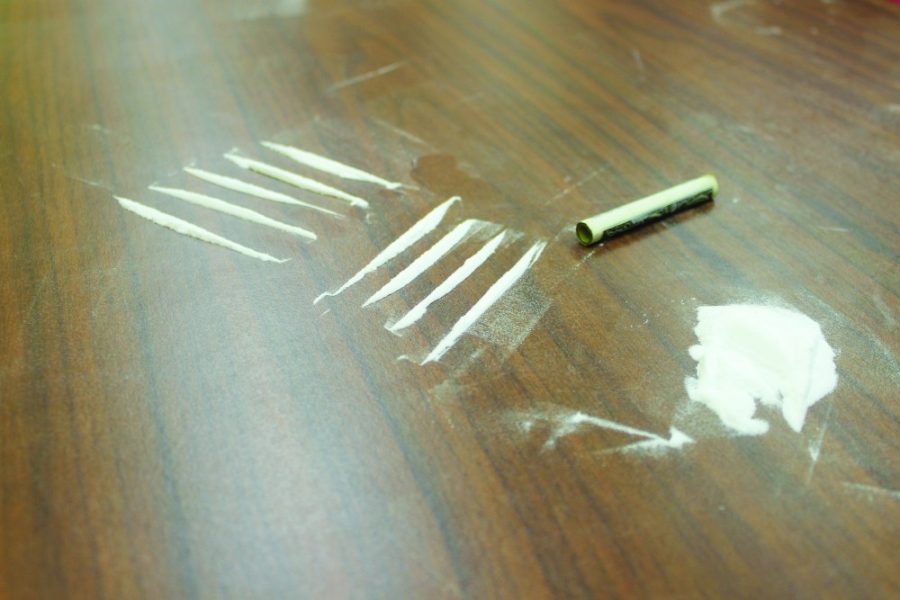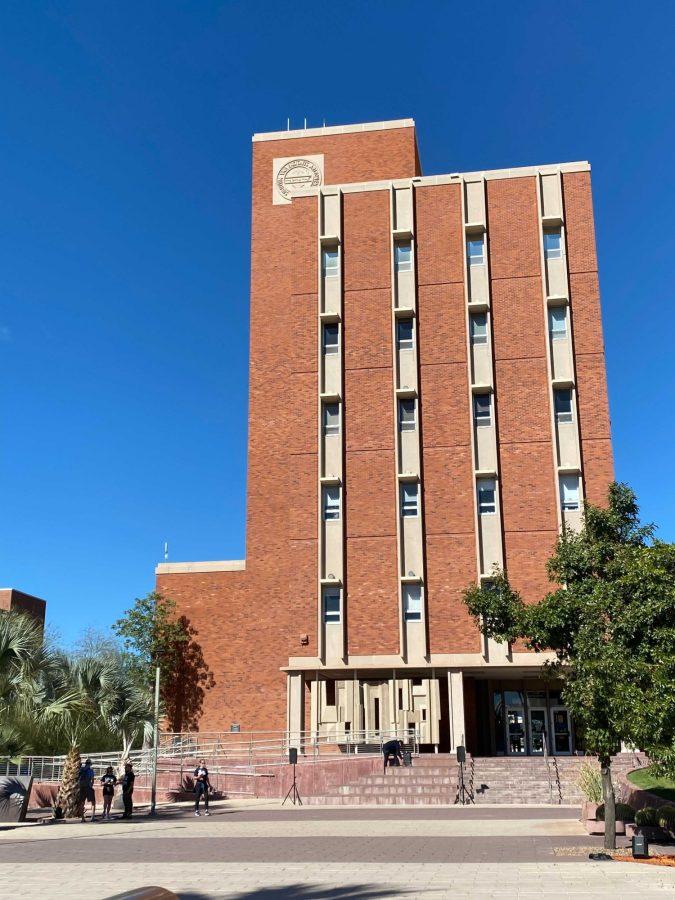The sound of an ambulance siren rang throughout the UA campus at 12:42 a.m. on a brisk December night. It’s never good news when an ambulance is called, and that day was no exception.
University of Arizona Police Department officers arrived to an ominous scene. Outside of 1103 E. Second St., laid an unconscious man. He was breathing but unable to stand, sit up or answer any questions.
The signs were all there: red and watery eyes, slurred speech, and a strong smell of intoxicants. The ambulance transported the man to the University of Arizona Medical Center. While he was at the hospital, he wouldn’t respond to hospital staff or UAPD. A nurse, who had been rummaging through his belongings, found a pink plastic bottle containing white powder. Upon closer inspection, officers discovered the white powder to be 5.7 grams of cocaine.
Cocaine on campus
Reports of cocaine use are rare on the UA campus. Last year, UAPD records showed only eight citations of cocaine use and possession. In total, 13.3 grams of cocaine were seized. Campus Health Service reported similar findings in their 2014 Health and Wellness survey, with only 2.9 percent of students admitting they used cocaine in the past 30 days. However, the student population has said otherwise, suggesting cocaine use is more popular than the data suggests.
“It’s more common than people think; if I wanted a gram of cocaine, I can get it delivered to me within half an hour,” said Michael Grey*, a UA student. “In fact, I’ve never gone to a person’s house to get the drug. I’ve actually only had it delivered. That’s how socially available it is.”
When asked to give an estimate, he supposed cocaine use is five times greater than the data Campus Health suggests. At any given party, 10 to 20 percent of those in attendance are using the drug, Grey said.
“That is a lot lower than what I expect for the school,” said Zach Hamm**, a UA student. “More than 2 percent of the people I know have tried it.”
The experience
Sometimes, curiosity gets the best of everyone. For Hamm, the call of cocaine came from his search for new experiences.
“I guess I was interested in trying [cocaine], because it was a different state of mind,” he said. “It was something that I hadn’t done. So, I was interested in how it affected me.”
Hamm first tried the drug at a party when he ran into someone who did cocaine in the past. Hamm said he knew the risk he was taking.
“It was something that I had known was bad for you, and I was … I guess of the mindset that it was something that I would try, just because I was curious,” Hamm said.
Minutes later, he did his first line of cocaine. Since then, he’s used cocaine a total of three times. Today, he said he doesn’t feel compelled to use it anymore, citing the heart issues that come with heavy cocaine use.
The first time Grey tried cocaine was his freshman year. As with Hamm, it was at a party.
“Basically, when I became involved with the Greek Life, it was sort of socially accepted, and it was just brought,” Grey said.
Peer pressure was absent. No one pushed him into doing the drug.
“It was so nonchalant that it was no big deal,” Grey said. “I just went into a room and did a line, and that was the first time.”
At certain times in his college career, he did it every other weekend.
“When I was using it, I wasn’t concerned about my health; I was only using it when I was drinking,” Grey said.
The price for a gram of good cocaine runs at about $50, according to Grey.
“You can definitely tell [the quality of the cocaine],” he said. “When you use it, it’s the numbness that you get. You get a numbing sensation throughout your mouth and your face sort of. Mostly in your mouth.”
The more numb the sensation, the more pure the cocaine.
Grey has since stopped using cocaine. He said he’s older now and the drug is more appealing to younger college students looking to experiment with drugs.
Cocaine facts
According to the National Institute on Drug Abuse, cocaine is a “powerfully addictive stimulant drug made from the leaves of the coca plant native to South America.” It can be snorted, injected or dissolved. The drug affects the central nervous system, flooding the brain with dopamine — a hormone that produces the feel good “high” of cocaine. In a stressful environment like college, it’s easy to see cocaine’s appeal.
“It’s just a really strong head rush, and you feel very powerful,” Hamm said. “It’s a strong sense of euphoria. You’re very up and energetic. It’s a cheap high. You’re very elevated. You feel very confident, up and powerful I guess, and really excited. But it fades very quickly.”
Grey had a similar reaction to his cocaine use and said that it makes the user more energetic and outgoing.
“You’re tuned in,” he said. “When you’re drunk, it kind of sobers you up a bit.”
The dangers of cocaine
Cocaine also comes with a number of dangerous side effects. In particular, it increases the risk of heart attack and stroke.
Lynn Reyes, a prevention specialist and substance abuse counselor at Campus Health, said cocaine increases “heart rate and blood pressure. It can take away and suppress appetite or sleep.”
It can also “cause headaches and gastrointestinal complications, such as abdominal pain and nausea,” according to the NIH.
Kelly Irving, the director of Women’s Substance Abuse for CODAC, worries students aren’t taking the effects of cocaine and the possibility of addiction seriously enough.
“When people start using drugs, they don’t realize that they are addictive, and it can become a problem,” Irving said. “‘Oh, I can do it; I’m not going to be like that. I can control it,’ type of thing.”
She said some addicts experience major life problems before they realize it “is actually a problem.”
The evolution of cocaine use
Irving has good reason to be concerned. In the UA party scene, cocaine use seems to be extremely casual. In fact, it’s been labeled by some as a social drug.
“It’s so socially accepted, and I mean, you see other people doing it,” Grey said. “Normally, you get into a room. They chop up a bunch of lines on a table, and about five or six people do a line and they go back out and party like it’s no big deal.”
Both Grey and Hamm said that cocaine and alcohol seem to go hand in hand.
“I was only using it when I was drinking, and it was normally Saturday morning when I was hung over and we were having a day party,” Grey said. “That’s how I would use it — to get me amped up for the party.”
Cocaine mixed with alcohol produces a chemical in the liver called cocaethylene. Cocaethylene “prolongs the effects of euphoria.” It’s dangerous, because cocaine users can drink considerably more than their body can tolerate. As a result, they become oblivious to the damage they’re inflicting on their own body, according to an article in The Guardian.
Cocaine’s withdrawal effects are intense. They include “fatigue, lack of pleasure, anxiety, irritability, sleepiness, and sometimes agitation or extreme suspicion or paranoia,” according to the NIH. However, students have found a shortcut around these withdrawal symptoms.
“The comedown on it is extremely bad,” Grey said. “You get very anxious thoughts. Typically, I’ve seen a lot of guys purchase Xanax for the morning after to chill them out.”
Irving stressed that mixing cocaine with Xanax is not a solution.
“Xanax and alcohol are both depressants,” Irving said. “And so you’re putting a depressant into your system as well as a stimulant. That really messes up your body. They don’t even out each other.”
Moving forward
Cocaine use comes with a number of complications. For example, it’s hard to identify whether an individual is on cocaine or not unless you actually see them do it, Reyes said.
There’s also no easy way to treat addiction.
“There’s no medication to help with the cravings or addiction to the drug,” Irving said. “Not like methadone would be for heroin addiction.”
It’s hard to determine how big the problem of cocaine use is on campus. There’s a strong possibility it is underreported; not many students will admit to using the drug in fear of arrest. There’s also a strong possibility of a vocal minority. It is possible cocaine use is rare on campus, just as UAPD and Campus Health reports.
“I hear anecdotally that people are feeling like a lot of people are using it; I think it depends on where you are and your perspective,” Reyes said. “If you’re hanging around with groups that use a lot of drugs or use a lot of cocaine, you’re going to believe that everyone is doing it.”
Editor’s note: The names of Michael Grey* and Zach Hamm** , both UA students, have been changed to protect the identities of the sources.
_______________
Follow Kethia Kong on Twitter.









